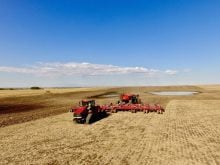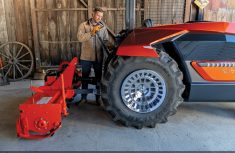There’s no doubt the demand for rubber-belt track systems on ag equipment continues to grow. Many new implements hitting the market are now designed specifically for tracks and don’t even offer wheels as an option. But no matter how you slice it, track systems boost the cost of an implement purchase pretty significantly. So, are they really worth the extra cash?
Two manufacturers say, their track systems offer definite, measurable advantages.
Manitoba-based Elmer’s Manufacturing recently released the findings of a study they say shows implement track systems can slow the rate the needle in a tractor’s fuel gauge falls. They conducted research near Altona, Manitoba, comparing tractor fuel consumption when pulling wheeled and tracked grain carts. The tractor pulling a cart equipped with their tracks showed an 11 to 15 per cent reduction in fuel consumption, according to the study.
Read Also

Claas brings 1000 Series SP forage harvesters to Canada
In mid-August, Claas unveiled its new line of Jaguar forage harvesters at an event in Visalia, California, deep in the heart of that state’s dairy region.
“We used a grain cart and compared wheels to tracks at the same weights,” explained Mike Friesen, general manager and lead engineer at Elmer’s, in a press release. “We tested on fresh tilled ground, tilled and then dried for a few days, untilled canola ground, and concrete for a reference.”
Wheels performed better than tracks on the hard concrete, but when the carts were pulled across softer surfaces typical of those in a field, that’s where the tracks shined.
Researchers believe the reason for that is because tracks “float” or stay higher on top of the soil, reducing rolling resistance. Tires, on the other hand, don’t have the same floatation ability and generally create deeper ruts, creating greater rolling resistance in soft soil.
“In plain English, the tracks don’t have to continuously try to get out of the rut they are digging like the wheel does,” explained Friesen.
Camso
Another track systems manufacturer, Quebec-based Camso, claims its research has also shown clear advantages when comparing tracks to tires in ag applications. Although they acknowledge growers will have to factor in the higher purchase costs, the investment will likely be worth it over the long haul.
“It’s difficult to achieve that same pure cost; but when you put the benefits in there, the advantages outweigh those of tires,” said Martin Lunkenbein, business line executive director of agricultural systems at Camso.
A couple of years ago Camso began a research program it calls “Profit from the ground up.” Its purpose is to measure what, if any, agronomic advantages growers can expect when using tracks instead of tires on a planter. The study links a yield advantage to tracks, because of their reduced impact on the soil during seeding.
“We’re showing a five per cent increase in yield,” said Lunkenbein.
And the Camso program also suggests, like the Elmer’s research, that farmers could expect to see a reduction in their annual fuel bills, particularly when tractors are fitted with tracks. The reason is because of the improved traction tracks offer.
“What you have to look at is how much work is being done in unit time,” Lunkenbein said. “You can get more work done in the same unit time, because you have less slip; and some of the studies are showing less fuel costs because you’re getting less slip.” †

















